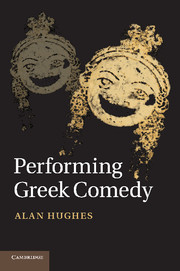Book contents
- Frontmatter
- Contents
- Illustrations
- Preface
- Chapter 1 Comedy in art, Athens and abroad
- Chapter 2 Poets of Old and Middle Comedy
- Chapter 3 Theatres
- Chapter 4 The comic chorus
- Chapter 5 Music in comedy
- Chapter 6 Acting, from lyric to dual consciousness
- Chapter 7 Technique and style of acting comedy
- Chapter 8 The masks of comedy
- Chapter 9 Costumes of Old and Middle Comedy
- Chapter 10 Comedy and women
- Chapter 11 New Comedy
- Catalogue of objects discussed
- Notes
- Glossary
- Bibliography
- Index
Chapter 8 - The masks of comedy
Published online by Cambridge University Press: 05 February 2012
- Frontmatter
- Contents
- Illustrations
- Preface
- Chapter 1 Comedy in art, Athens and abroad
- Chapter 2 Poets of Old and Middle Comedy
- Chapter 3 Theatres
- Chapter 4 The comic chorus
- Chapter 5 Music in comedy
- Chapter 6 Acting, from lyric to dual consciousness
- Chapter 7 Technique and style of acting comedy
- Chapter 8 The masks of comedy
- Chapter 9 Costumes of Old and Middle Comedy
- Chapter 10 Comedy and women
- Chapter 11 New Comedy
- Catalogue of objects discussed
- Notes
- Glossary
- Bibliography
- Index
Summary
In the 1950s, two plaster masks hung above the screen in my local cinema, the corners of their gaping, stylized mouths sweeping downwards for tragedy, and up for comedy. Every popcorn-eating kid at the Saturday matinee understood that these were symbols of theatre and film. They still are: a website dedicated to them offers 500 designs. Today, we use ‘mask’ as a verb, synonymous with ‘hide’ or ‘conceal’: cedar siding masks an ugly concrete wall, a villain is unmasked. A Greek actor's prosopeion concealed his face, but perhaps not his identity, which the judges must have been able to recognize in order to award a prize. Each time he donned a fresh mask, it instantly defined a dramatic character, showing the audience a new face (prosopon), a separate being who was more than an actor pulling faces. Recognizing its general characteristics, spectators could promptly identify each mask by type: hetaira or kore, slave or old citizen. Within a type, distinctions between Peisetairos and Euelpides, or the individuality of Lysistrata and the Sausage-seller, emerged with further acquaintance.
What masks were like
No Greek masks have survived, but thousands of images in painting, sculpture, terracotta models and bronze show that the actor's head was entirely enclosed. Masks were composed of a rigid, moulded face, with attached hair, in varying proportions according to type. Tragedy masks usually had abundant hair, which the actor could simply lift in order to enter from the rear. Since comedy masks were often bald on top, the crown must have been moulded in one piece with the face; hair at the back and sides completed the mask. The face surrounded the actor's head sufficiently to carry the ears, which were often large; for satyr plays they were inhuman, pointed and obviously artificial. Masks of men were brown, those of young women, white. The mouth of a mute ‘extra’ could be closed, but a speaking character's mouth was necessarily open, and often very large, but without visible teeth except in several Hellenistic replicas, where the actor's mouth may be seen inside.
- Type
- Chapter
- Information
- Performing Greek Comedy , pp. 166 - 177Publisher: Cambridge University PressPrint publication year: 2011



